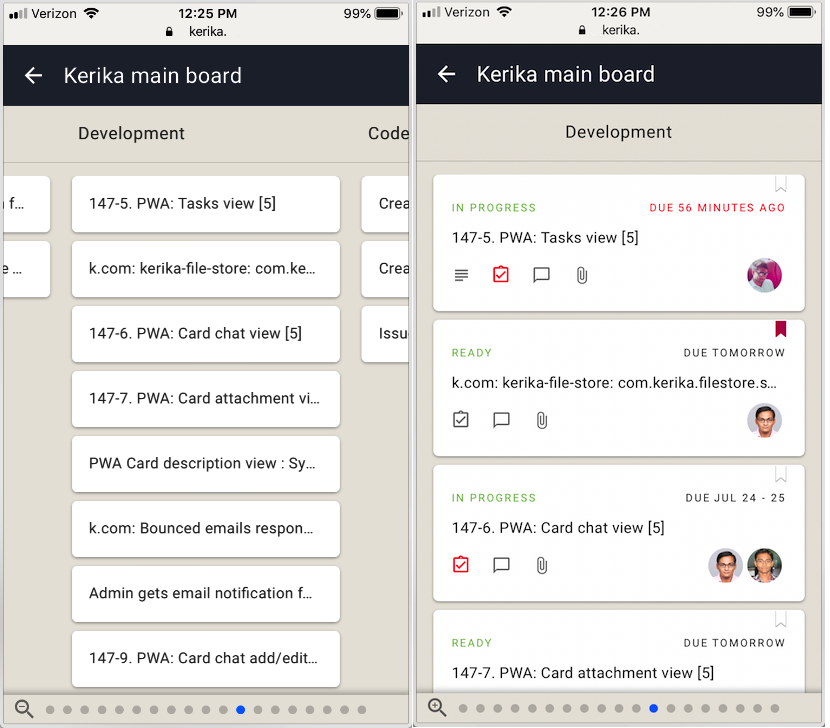
We will start to do IP blocking
Regrettably, we will start doing IP blocking to stop persistent spammers from setting up Kerika accounts.
We have seen a consistent pattern of misuse that goes like this:
- Someone signs up with a sina.com email address. Sina is one of the largest ISPs in China, but we don’t have any users in China for the simple reason that most of Google’s services are blocked by China’s Great Firewall, and Kerika has a tight integration with Google’s G Suite.
- The spammer isn’t actually located in China; they are in Manila (Philippines) and come from IP addresses like 203.177.13.60
- These spammers send out hundreds, sometimes thousands, of invitations for users from the qq.com domain to join their (spurious) Kerika team.
- These recipients are all users of Tencent’s QQ messaging system, based in China. Again, none of them would be actual or potential Kerika users, since the recipients are all located in China.
The user impact of this spamming was relatively small: almost no one with a qq.com email address would reply to these invitations, but the conduct was a very clear misuse of Kerika and harmful to our reputation, quality and brand.
(Among other things, these spurious invitations would pile up in the thousands.)
We have decided, therefore, to start blocking IP addresses using Amazon’s VPC service (since we use Amazon AWS extensively on our back-end.)
This is a brute force method, and not ideal, but we were starting to get really annoyed with these folks. We hope this doesn’t impact any of our real users in the Philippines; if you are affected, please let us know!
Adding support for Limerick Institute of Technology
We are adding the Limerick Institute of Technology (LIT) to the list of organizations supported by Kerika’s Academic & Nonprofit plan.
Everyone signing up with a @lit.ie email will automatically get a free Kerika account that can have up to 10 people working on their boards.
Adding support for University of Trento
We are adding the University of Trento (Italy) to the list of organizations supported by Kerika’s Academic & Nonprofit plan.
Everyone signing up with a @studenti.unitn.it email will automatically get a free Kerika account that can have up to 10 people working on their boards.
How to install Kerika from the G Suite Marketplace
An updated primer, showing for organizations that are using G Suite (formerly known as Google Apps for Business) can install and authorize Kerika for their domains:
1. Go to your G Suite Admin Console
The organization’s Google Admins (and there’s usually more than one such person) can view their Google Console at https://admin.google.com: click on the Apps button.
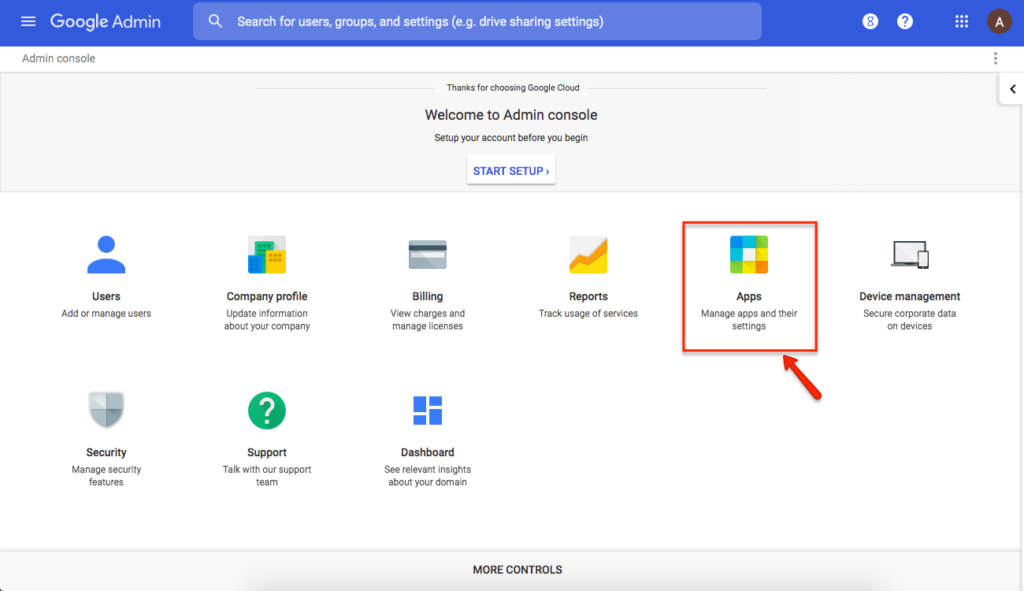
2. This will take you to all your Google-related apps.
Kerika falls into the Marketplace Apps category, so click on that button.
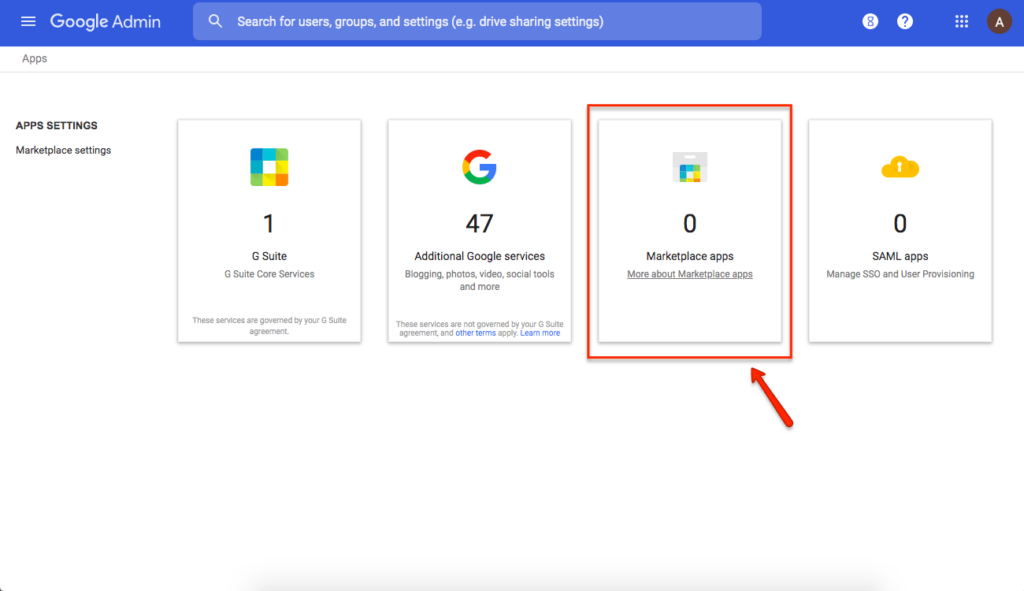
(All the other buttons are for apps from Google itself; Marketplace is where third-party vendors like Kerika show up.)
3. Click on Add Services
This will take you to the G Suite Marketplace
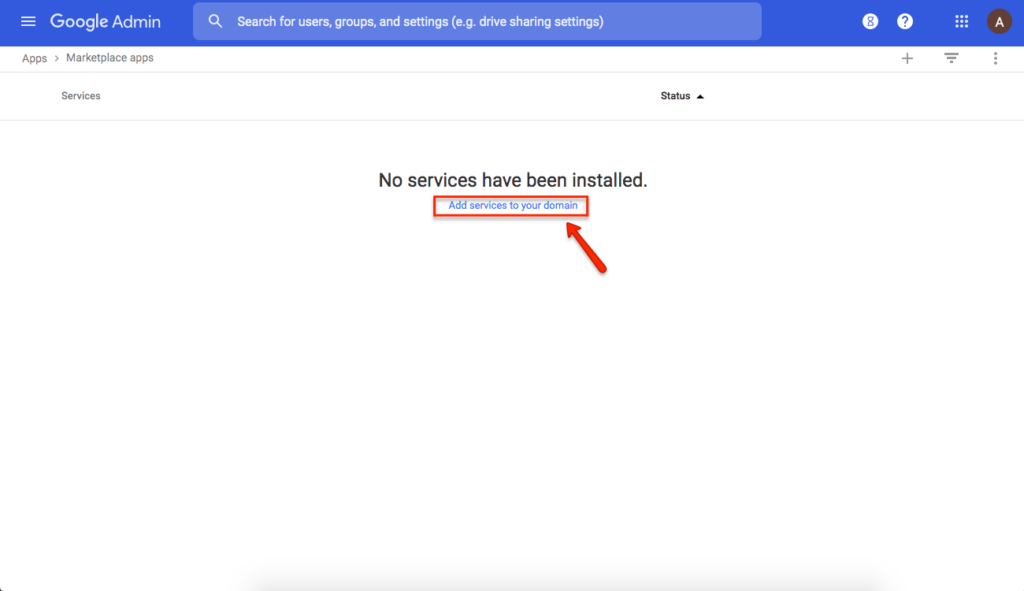
4. Search for Kerika
It would be nice if Kerika showed up right away, but you need to search for it in the box shown below:
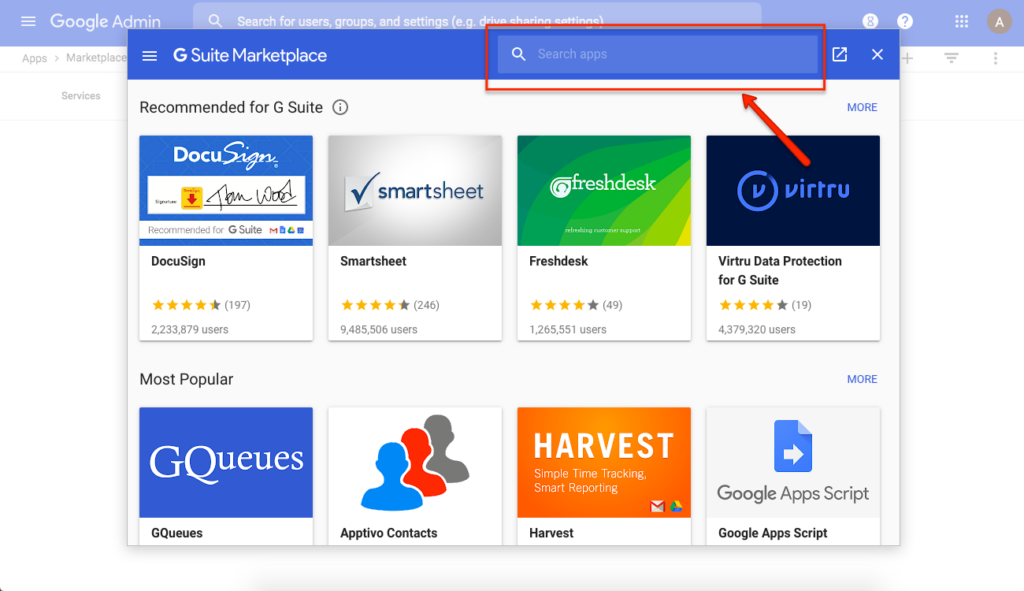
5. Select Domain Install
The Domain Install option will allow everyone in your organization to use Kerika:
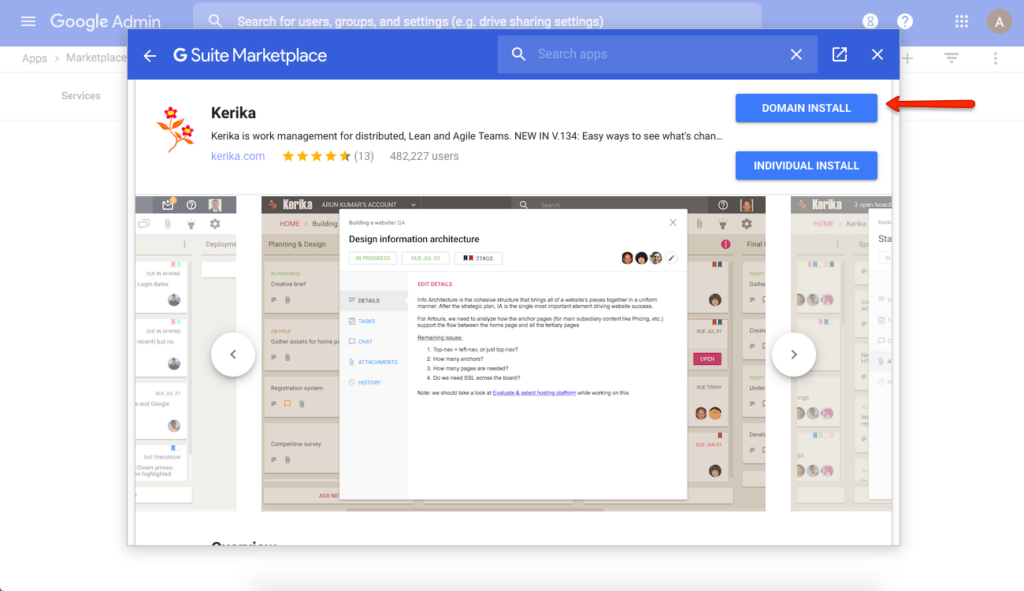
6. Accept the Terms
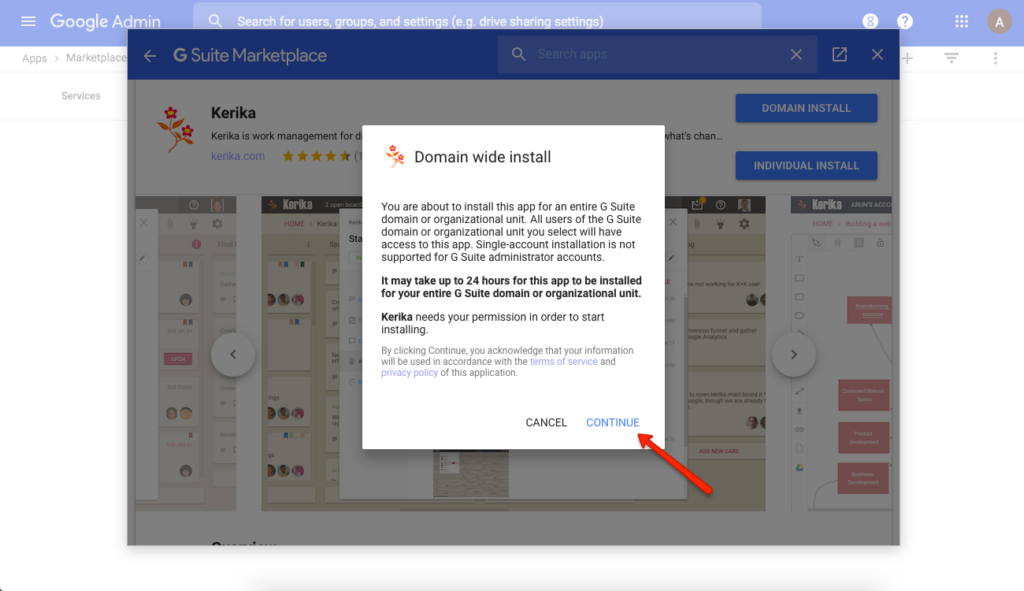
7. Success!
Kerika is now installed for your organization’s use:
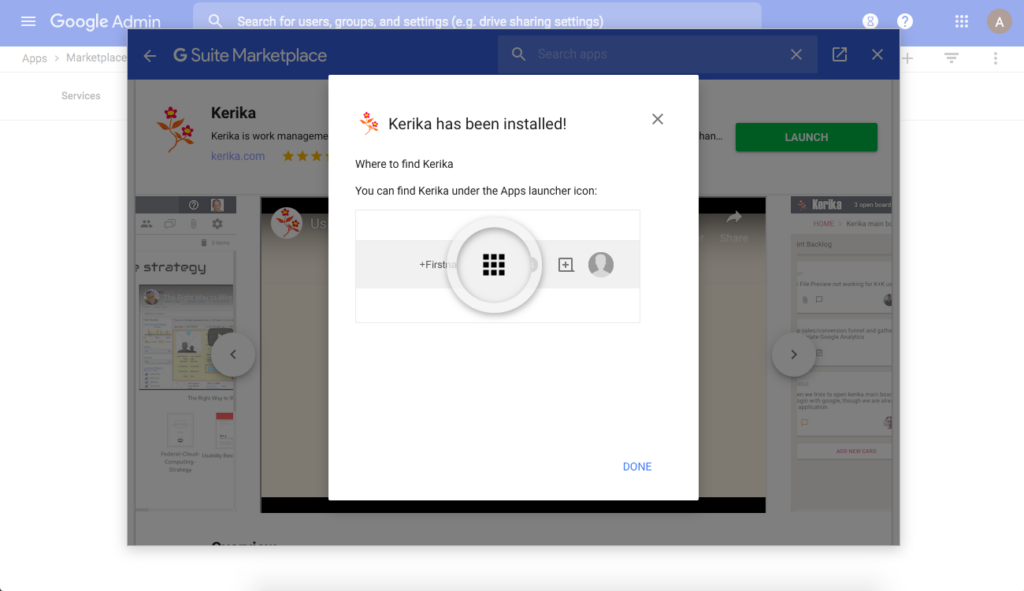
8. All done
You are all done. Enjoy Kerika.
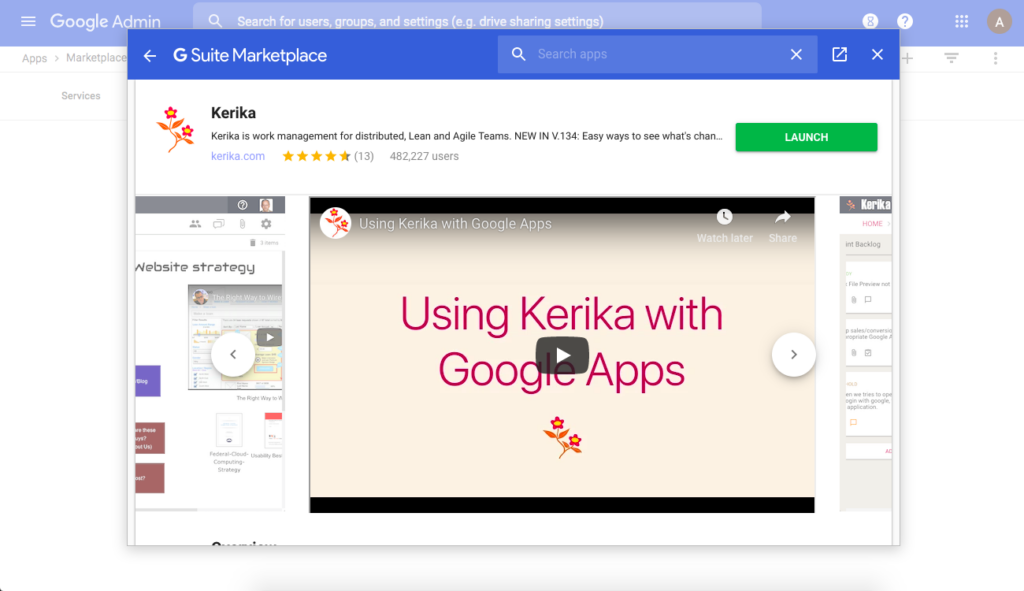
Shifting to Google Drive for our Direct Signup Users
We are making a significant change to how we store and manage project files for users who sign up directly (using an email), and we are getting close to finishing our internal testing. Here’s what’s coming, and why.
Background:
Previously, when someone signed up directly (with an email address) Kerika would automatically create a new Box account linked to that user, and use this account to store the user’s project files.
This was done by Kerika’s servers: our end-users didn’t have to do anything and, in fact, had no direct access to these Box accounts.
The trouble with this approach is that we ended up with three islands of users: people who had signed up with their Box IDs (Kerika+Box); people who had signed up with their Google IDs (Kerika+Google); and people who had signed up directly.
These islands were isolated: you could collaborate only with users who had signed up the same way as you had. In other words, someone who had signed up using a Google ID could not collaborate with someone who had signed up using their email, because the first user’s project files were getting stored in her Google Drive, while the second user’s files were getting stored in a Box account.
(And over time the ratio of people who preferred Google over Box became increasingly lopsided.)
New Architecture
We are now implementing a new storage model that will deliver four important benefits:
- You will be able to collaborate with any other Kerika user, regardless of how the other person signed up. You can invite anyone using their email, and not worry about whether the other person has a Google or Box ID. If you accept an invitation to join a team, it won’t matter how you sign up. No more isolated islands.
- Previously we would ask for access to your entire Google Drive if you signed up using a Google ID; now, we can limit our access to only those folders that Kerika itself creates and manages.
- Folks coming via the Google Apps Marketplace can try Kerika without first having to get authorization from your Google Apps Admin. Authorization is actually needed only when you want to upload files to your Kerika boards.
- Our direct signup users can benefit from Google Apps (Sheets, Slides, Forms, etc.) even if they had previously not used these apps. Direct signup users will be able to create new Google Docs; something that previously was limited to people using Kerika+Google.
How this will work:
Kerika will have a master Google Drive account, and inside this we will create separate, access-controlled folders for each (direct sign up) user. This will bring all the Google Docs functionality to our direct sign up users.
From a security perspective, we believe this will be good: each user’s project files are stored in a separate folder within Kerika’s Google Drive, and each user has access only to their own folders.
We believe this is good in terms of privacy, too: because Kerika has an enterprise Google Drive account, we get the additional privacy protection afforded to paid/business users of Google Apps. (Your files won’t get scanned by Google for any advertising purpose.)
We will do all the work needed to move our direct signup users from Box to Google Drive; no one should be inconvenienced!
Free Kerika Accounts for University of California Riverside
We added ucr.edu to the list of domains that automatically qualify for free Academic Accounts: sign up with a ucr.edu email and you will automatically get a free 10-user plan.
Requesting a Refund or Credit for your Account
In our previous blog post, we explained how an Account Owner can remove someone from their Account Team, or reduce their role to a Visitor. Both options can help if you want to reduce the cost of your Kerika subscriptions, since you don’t have to pay for Visitors.
Once the number of Team Members and Board Admins in your Account Team falls below the licensed (paid-for) amount, you can shrink your subscription count as well.
(You need to reduce the size of your active Account Team first, before you can reduce your subscription count since Kerika automatically checks to make sure you are paying for all of your current Team Members.)
To manage your subscriptions, click on your photo/initials on the top-right corner of the app:

A dialog will appear; select the Manage My Account option:

This will take you to your Account page inside the Kerika app:
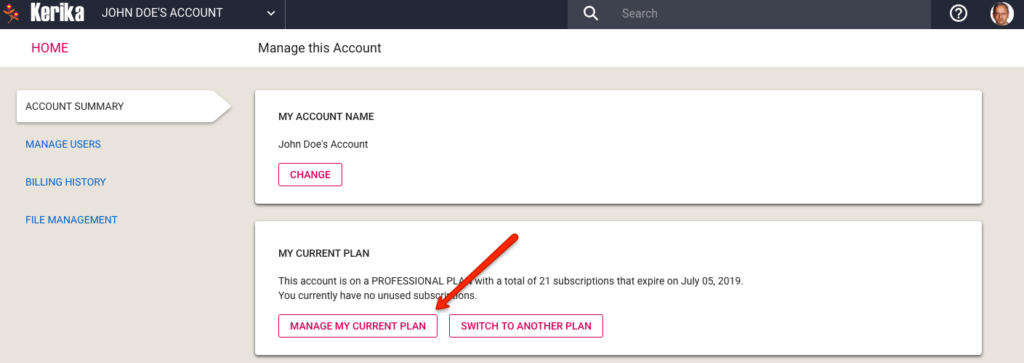
A section within this page shows the size of your current plan, and whether there are any unused subscriptions. If you had followed the steps for reducing the size of your Account Team, you should have unused subscriptions shown, as in the example above.
Click on the Manage My Current Plan button, and you will see a dialog like this:
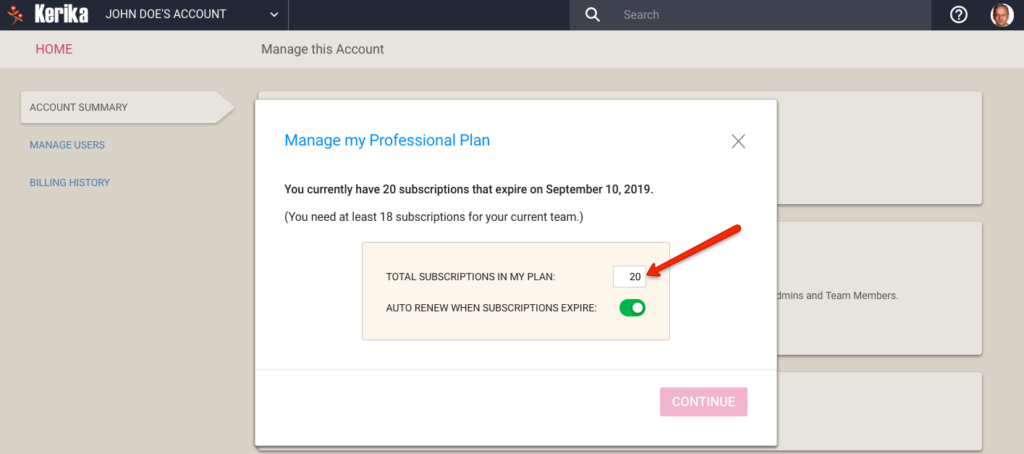
In the example shown above, this account has 2 unused subscriptions, and the Account Owner can reduce her Kerika plan down to 18 users. When the subscription plan size is changed, Kerika calculates whether you are owed a refund or need to pay more (if your plan increased in size).
This calculation is based upon the number of days left before your existing subscriptions expire. In this example, the user can get a refund of $74.10:
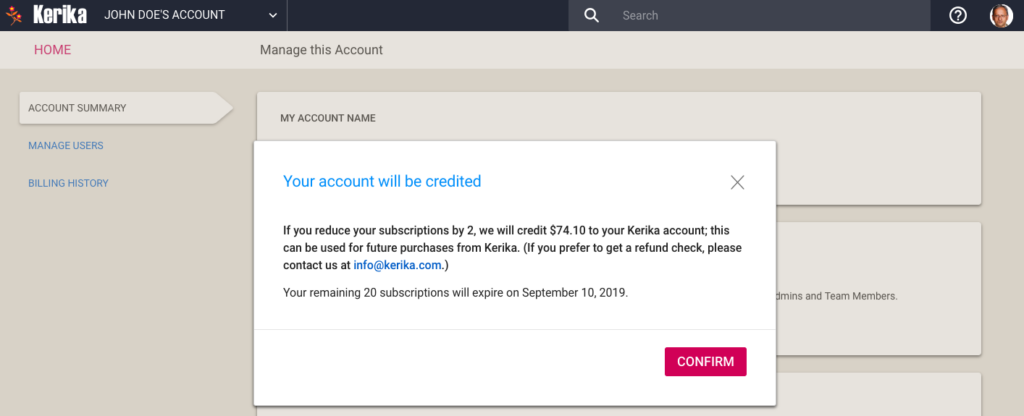
After confirming her request, the user’s Account Summary page now reflects the credit she has gotten by reducing her plan size:
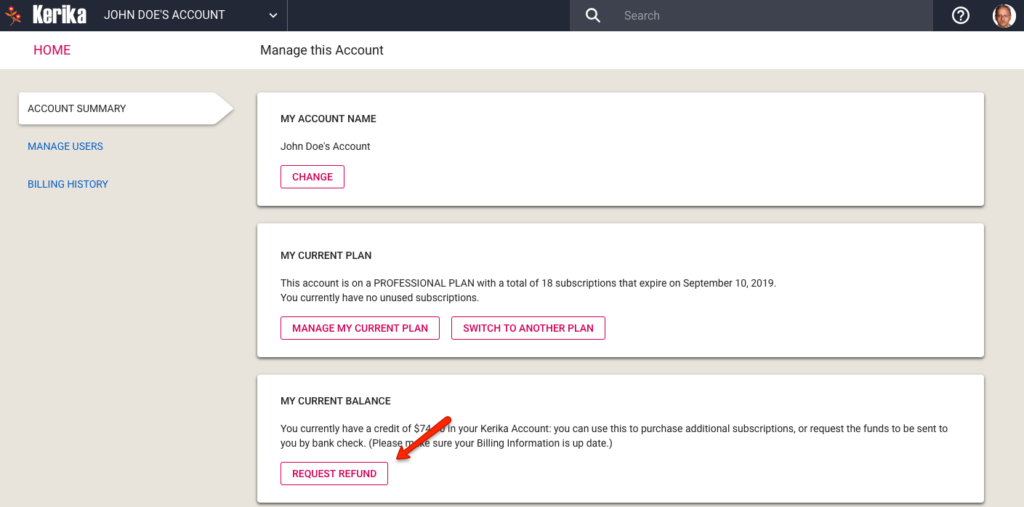
Most people leave the credit in place because small changes in their Account Team are expected, both in terms of reducing Team Members and increasing them.
If you are sure that you will never use the credit, you can click on the Request Refund button (shown above) and a refund check, drawn in US dollars from a US bank, will be sent to the user’s billing address. (So make sure your billing address is up to date!)
Removing someone from your Account Team
The Account Owner can remove, or downgrade, any member of her Account Team: this is a simple, instantaneous action that can be done while logged into Kerika.
While logged in, click on the the user photo (or initials) that appear at the top-right corner of the app:

Then select the Manage My Users option in the dialog that appears:
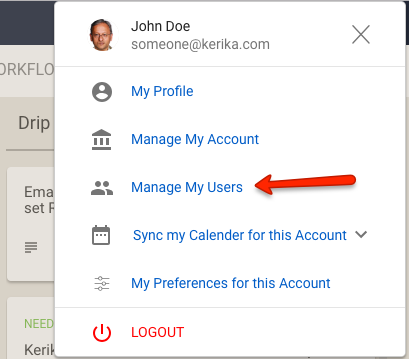
This will take you to your Account Management page with all the users listed:
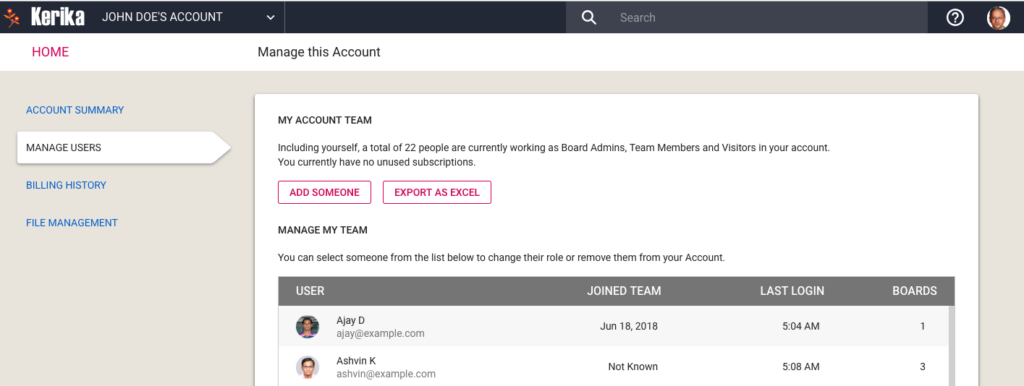
When you hover your mouse over any of the people listed, user management actions appear as buttons:

Clicking on the Manage User button offers two actions for someone who is currently a Team Member in your Account Team:

The Remove from Account action will remove this person from every board owned by your Account. This can’t be undone, so take care if you do this!
The Make This User a Visitor action will change this person’s role to a Visitor, across any boards owned by your Account where this person was originally a Board Admin or Team Member.
Use the Remove action when you simply want to exclude someone from everything in your account, e.g. if an employee resigns.
Use the Make Visitor action if you don’t expect this person to have an active role in any of your boards, and you don’t want to pay for this person’s subscription anymore.
Visitors will continue to show up in your Account Team list, but you don’t need a subscription for them.
Free Kerika Accounts for folks at University of Malaya
We have added the University of Malaya to the list of domains from which people can automatically qualify for a free Academic Account: anyone signing up for Kerika+Google with a um.edu.my email — students, teachers and administrators — can automatically qualify to have up to 10 Team Members working on boards owned by their account.
Enjoy!